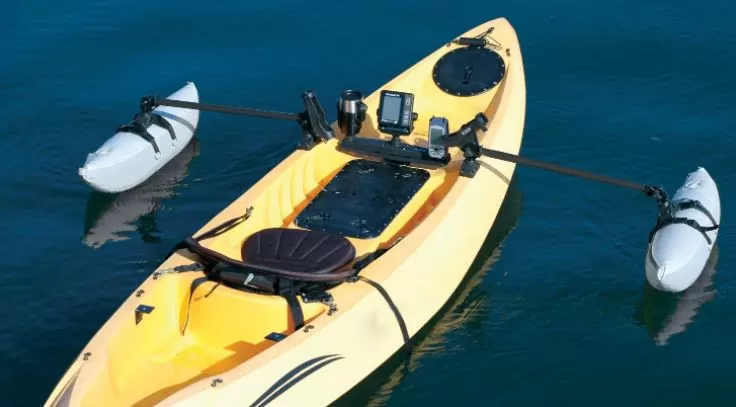Every kayak is designed to meet the needs of a certain weight limit. No matter what kind of kayak you are using, it’s important to know your weight and limits.
Don’t be tempted by the idea of letting your kayak carry more weight than it can handle because this will only make you unhappy with its performance.
Do you know those kayaks that say “Max Capacity”? Yeah, don’t use it. In fact, you should try to keep your load well below the rated capacity for an even more enjoyable and safe experience in the water.
But, How accurate are kayak weight limits? We know that you have plenty of questions, but don’t worry! We’ve put together this page with answers to all your weight-limit-related inquiries. So stick around and take a look at what’s below for solutions tailored just for.

- What Is a Kayak’s Weight Limit? Is There a Weight Limit To Kayaks?
- How Accurate Are Kayak Weight Limits?
- What Happens If You Exceed The Weight Limit On A Kayak
- How Much Weight Does An Average Kayak Hold?
- How To Calculate A Kayak's Weight Limit For Optimal Performance
- Is There Any way to Increase Kayak's Weight Capacity?
- Concluding Thoughts On Kayak's Weight Limit
What Is a Kayak’s Weight Limit? Is There a Weight Limit To Kayaks?

Kayak weight limit is a common spec listed on the kayak’s website or instruction manual. While it may seem like an insignificant detail, this number can make all of the difference in how your day goes.
Maximum weight limit, load capacity, and maximum capacity are rating systems that indicate how much weight a kayak can hold without sinking.
The maximum capacity ratings on kayaks are supposed to simplify the process of choosing a suitable boat, but as it turns out these measurements can be confusing. For starters they end up causing confusion among both beginners and experts in paddling communities due to two things:
The maximum capacity ratings on kayaks are supposed to simplify the process of choosing a suitable boat, but as it turns out these measurements can be confusing. They end up causing confusion among both beginners and experts in paddling communities due to two things:
One, There are no industry standards for determining this information, so each kayak brand and manufacturer will have their own rules on how much you can haul in theirs
Two, Many people are under the false impression that weight capacity ratings on kayaks indicate the paddler’s weight. If a kayak can only carry 250 pounds, don’t assume that it is for a 250 lbs person. It means a loaded kayak with a total of 250 pounds will keep it afloat, even though the boat is far from being usable.
It would seem that there is no industry standard for determining weight capacity, but most experts agree on the following three factors:
- Length of the kayak’s hull
- Width of the kayak
- Buoyancy (water volume displaced)
How Accurate Are Kayak Weight Limits?
The kayak weight limit is meant to represent the absolute upper threshold for how much you can carry in your vessel.
When shopping for a kayak, make sure to read the weight capacity. Many manufacturers advertise this number and it can be tempting to go over your limit if you’re trying out different models or brands. But in reality, the threshold at which performance starts decreasing by too much weight usually occurs well below their advertised limit.
The 25-Percent Rule is a general rule for experienced kayakers to determine the upper limit of what they are comfortable with.
What Happens If You Exceed The Weight Limit On A Kayak

Every kayak has a weight limit, which is usually printed on the rental equipment or in its manual – but it’s still important to know before you go.
But can you load up your kayak to its maximum weight limit? And what happens if you do it?
The weight of everything (including your weight) onboard should stay below the specified kayak weight limit or maximum capacity figure if you want it to keep afloat with ease.
A few things will happen if you exceed your kayak’s weight limit.
The first sign of trouble is that your yak will sit lower in the water than usual until it starts filling up with water and sinks even further.
If you overload your kayak, by exceeding its weight capacity especially if there is poor weight distribution throughout its structure, then it will not only affect stability but also make for an even more precarious situation. Kayaks are prone to capsize due to their tippy nature so this only increases the risks of flipping over in the water.
It’s important to note that even if you still stay afloat, You’ll face difficulty in paddling, maneuverability, and tracking.
How Much Weight Does An Average Kayak Hold?
Most kayaks are designed to serve a variety of purposes and have different materials construction. This is why the weight limit for a kayak varies.
Weight Limit Of Recreational Kayaks
Recreational kayaks are often the most basic models for a paddling trip and they’re not meant for transporting a lot of extra gear. The weight capacity they offer is the lowest among all kayak types.
The average weight limit of a recreational kayak is 250-300 pounds, depending on its type and size.
Weight Capacity Of Touring Kayaks
Touring kayaks are an excellent choice for the solo paddler who wants to cover long distances and is willing to bring along camping equipment. These boats act as a stark contrast with recreational yaks.
And for touring, you usually bring lots of supplies with you including tents, bags, and other outdoor gear.
The weight limit for this style of kayak is between 300 and 350 pounds.
Weight Limit Capacity Of Sit On Top Kayaks
Sit-on-top kayaks are the best choice for beginners and smaller paddlers because they’re wide enough, stable, and easier to use. The self-draining scupper holes keep water from weighing your boat down.
The second thing that differentiates them from their sit-inside counterparts after the enclosed cockpit is weight capacity.
The weight limit of a sit-on-top kayak is up to 100 pounds higher ( varies between 350 to 400 lbs) than the average 300-pound rating for closed cockpit-style models.
Weight Capacity Limit Of Inflatable Kayaks
Many people are skeptical of inflatable kayaks because they worry about how durable these boats can be. However, many high-quality models have surprisingly heavyweight limits that exceed those for other types of watercraft and handle more than you would imagine.
Kayakers love the freedom and versatility that inflatable kayaks bring. They can easily accommodate any size person, as well as hold between 400 to 750 pounds.
Weight Limit Capacity Of Fishing Kayaks
Fishing kayaks are designed to carry all of your essential fishing equipment for a full day on the water. Though they have an average weight limit between 350 and 400 pounds, it’s not hard to find models on the market that can hold more weight.
Weight Limit Capacity Of Tandem Kayaks
You know what they say, “Two is always better than one.” That statement couldn’t be more true when it comes to kayaking. This type of kayak can hold twice as much weight as its single counterparts because they’re meant for more passengers; there are extra supplies, more paddling equipment, water bottles, snacks…everything.
Tandems are often the most stable and efficient of all kayaks. They’re wider, longer – usually measuring 14 to 18 feet in length. The increased size of the hull means that the average maximum weight limit varies somewhere between 500-600 pounds.
How To Calculate A Kayak’s Weight Limit For Optimal Performance

A kayak’s advertised weight capacity will almost always be higher than its true weight.
How you can determine the right kayak weight limit can be a difficult question for someone new to kayaking. So let’s start with this confusion.
An expert suggestion for optimal kayak performance is to load the kayak around 30% less than what it can handle. It is important to stay at about 70% of the kayak’s specified maximum capacity. This will ensure that you stay well within safe limits and don’t end up capsizing due to too much weight or poor balance.
Maximum Weight Capacity
You’ll want to make sure that your total weight requirements include everything, from the bodyweight of yourself and all equipment used in addition to any passengers on an average trip.
- First of all, find the advertised capacity.
- Multiply the advertised capacity (shown on the official kayak website) by 0.30.
- Then subtract this figure from the advertised weight capacity.
- You will get the true weight capacity for optimal kayak performance on the water.
True Weight Capacity = Advertised capacity – (Advertised weight capacity x 0.3)
For example, the advertised capacity is 300lbs. Then the true weight capacity will be calculated as follows.
True weight capacity = 300 – (300 x 0.30)
True weight capacity = 300 – 90
True weight capacity = 270 lbs
Another good practice is to calculate all the load you are going to put on your kayak. For example, your weight is 200lbs and all the gear weighs around 100 lbs. So the total makes it 300lbs. Now divide this total weight by 0.7.
Maximum weight capacity = Total Weight/0.7
Maximum weight capacity = 300/0.7
Maximum weight capacity = 430 lbs
So you must opt for a kayak that has a rated capacity of at least 430 lbs or more.
Is There Any way to Increase Kayak’s Weight Capacity?
In order to enjoy your time on the water, investing in a new kayak that’s capable of carrying more weight might be worth it than doing alterations to the existing one.
“It’s a sad day when I have to tell you that there is absolutely nothing any of us can do about increasing your kayak’s weight limit.” The only way in which it gets better? Improving buoyancy and allowing for more equipment on board without making people feel like they’re going underwater faster than necessary.
Adding Float Bags
Float bags are a type of accessory that can be used with kayaks to increase their flotation capacity. This makes them ideal for use in Class III, IV, and V whitewater rapids where extra stability is needed because the water may get rough sometimes. In addition, they could be a suitable option for other kayak types as well to increase the buoyancy and weight capacity.
In the end, it is a tradeoff. You sacrifice some maneuverability in order to get that slight boost of buoyancy.
Installing Outriggers

The idea that outriggers would increase the weight capacity of your kayak is totally a misconception.
It would only make your kayak feel more stable when it’s loaded down close to its maximum capacity.
But on the downside, kayaks with outriggers can be cumbersome and difficult to use for long-distance touring. They also get in the way of your fishing line, which could make it hard to reel a catch. For instance, you cannot paddle as fast with them due to their size getting in your way and making it difficult to propel the vessel.
Concluding Thoughts On Kayak’s Weight Limit
If you are new to kayaking and still unsure of which kayak will be best for your needs, just know that it’s a good idea to avoid a craft that barely meets your weight limit.
The best way to ensure your yak can handle whatever adventure it is that takes place on the water would be by getting one with a higher weight capacity. Don’t let the cost stop you though, my advice for finding the right one would just be to do some math and go with whatever limit fits your budget. Make sure that your yak will be able to take on all the weight you put on it.
The weight capacity is going to be an essential factor for determining the kayak’s performance, safety, and buoyancy. I hope you have a better understanding of the kayak weight capacity now. It won’t be hard, as long as it’s within your limits.

Hi, I’m Randy R. Lios and the owner of Floating Kayaks. I’ve always been adventuresome at heart. From the time, I got my first kayak at age 18 until now when I have multiple kayaks with accessories and spend 5-6 hours researching all the new related stuff in the market. I have always been fond of fishing since my childhood and kayaking is part of my weekend routine.
